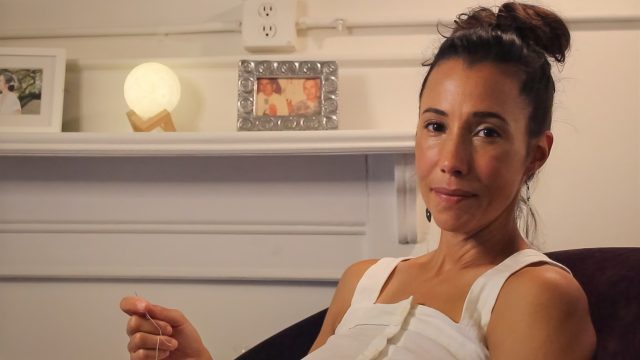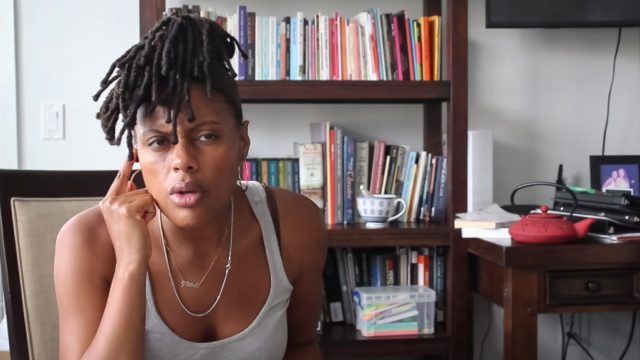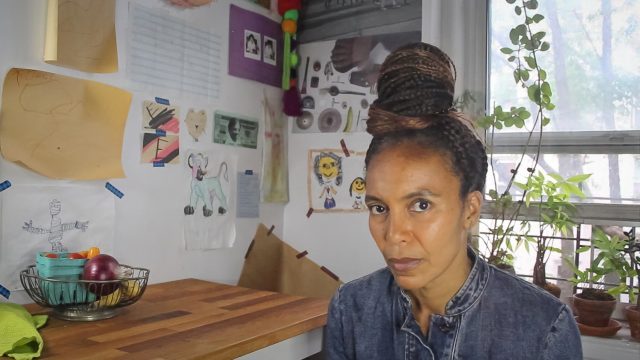
Shyla Lefner discusses Native American voting rights in in DeLanna Studi’s Before America Was America (photo by Cherie B Tay)
HERE WE ARE
Theatre for One
Thursday nights through October 29, free with advance RSVP, 6:00 – 7:30
Tickets available every Monday morning at 10:00 for that Thursday’s performances
theatreforone.com
bfplny.com
In the October 1 New York Times Offstage discussion “How I Miss Broadway,” Jessie Mueller, Neil Patrick Harris, Danielle Brooks, and Audra McDonald talked about what they missed most about live theater. “I miss the holy communion between the audience and the performers,” six-time Tony winner McDonald said. “It all happens right there in the moment. You’re forced to be in that moment with this group of people that you will never be all together with again, and there’s something so magical about that. . . . We all start to beat with one heart; our humanity comes through as that one being. We become this one thing.”
During the pandemic lockdown, I have watched a lot of theater online, but as good as some livestream Zoom readings, very short new works made with cellphones, and previously recorded stage performances have been, they cannot capture the rush that comes when you walk into a theater, take your seat, skim the Playbill, then wait with intense anticipation for the lights to go down and the curtain to rise. “I miss the live energy exchange with the audience,” Mueller longingly explained. Only theater can foster that kind of intimate relationship, where you are part of a crowd but also believe that the actors are speaking specifically to you, that the writer’s words are meant just for your mind, heart, and soul.
Theatre for One’s “Here We Are” comes the closest to conjuring that feeling, that swell of emotion between audience and performer. It is not only a brief, temporary panacea for what ails you; it fills a deep need for those desperate for live theater to return, taking advantage of current technology to make that exhilarating connection again.
Over the past ten years, Tony-nominated set designer Christine Jones has been touring Theatre for One, short plays performed for one person at a time inside a mobile four-by-eight-foot repurposed musical equipment container. She and co-artistic director Jenny Koons have now reimagined the project for the internet, commissioning eight works written, directed, and performed by BIPOC women (with one exception), presented live for one person at a time, sitting at home in front of their computer. The key is that not only do the actors have their video and audio turned on but so does the audience member, allowing the performer to gauge the viewer’s reaction in real time — and in some cases even engage in very brief conversation.

Nikkole Salter has a lot to say about race and publishing in Lydia R. Diamond’s Whiterly Negotiations (photo by Cherie B Tay)
Every Monday morning at ten, free timed tickets for that Thursday’s shows become available, but they go in a hurry; blink and they’re gone, so don’t hesitate. Each play generally lasts between five and eight minutes; on Thursday at your scheduled time, you follow a link and enter a code, which sends you into a kind of chat room while you wait to be sent to your show. You won’t know which play you will see until it starts; you cannot choose in advance, which adds to the excitement and mystery. Over a dark gray screen, other anonymous audience members make comments that appear in text bubbles that fade after a few seconds, evoking the whispers overheard while you get comfy in your theater seat, standing by expectantly for the show to begin. Just as one occasionally engages in small talk with one’s seatmates, you are encouraged to engage with the others online, mentioning where you’re from, expressing how you’re doing during the pandemic, and opining about how much you miss live theater. An unidentified facilitator keeps the discussion going as some people are whisked away to their show and others continue to hang out. Be patient; it sometimes takes ten or fifteen minutes before you go to your show, but this period can be very peaceful and calming. Don’t keep checking your watch or social media; as McDonald said, be in the moment.
And then it happens: The comment bubbles disappear, your camera goes on, and you are suddenly face-to-face with an actor filling your screen. It’s a stunning encounter that will have you breathless at first; it can also be a bit awkward, as you don’t know whether to say anything, either at the beginning or later in the piece, when a question might or might not be rhetorical. The actors are ready for all circumstances, but you should definitely err on the side of caution, as you would at an actual theater. That said, there do seem to be occasions when a response is fine. When I saw one work for the second time, the actress paused when she saw me, recognizing me, and asked whether I wanted to see something else instead. I said no, that I would love to see the play again, and I enjoyed it even more this time around, perhaps partly because of that extra personal contact.

Eisa Davis recalls a haunting memory in Lynn Nottage’s What Are the Things I Need to Remember (photo by Cherie B Tay)
I’ve seen seven of the shows thus far, and they have all been captivating and deeply affecting, dealing with the current state of the world without getting too overtly political. In Jaclyn Backhaus’s Thank You Letter, directed by Candis C. Jones, the endearing Mahira Kakkar shares a letter she wrote to civil rights pioneer John Lewis, detailing how his crossing of the Edmund Pettus Bridge impacted her Indian family. In Lynn Nottage’s What Are the Things I Need to Remember, superbly directed by Tiffany Nichole Greene despite the clear limitations of physical space, Eisa Davis portrays a woman who brings up an old memory that still haunts her. A memory is also at the center of Carmelita Tropicana’s Pandemic Fight, directed by Rebecca Martinez, as Zuleyma Guevara recalls battling with her ex-boyfriend, a straight white Buddhist monk, over race. “In my pandemic university I’m majoring in race and white fragility,” she says. “I’ve had a crash course getting woke and I’m amazed at how much I did not know. In this pandemic are you having fights with your loved ones? Because I am.”
Lydia R. Diamond deals with another aspect of race relations in whiterly negotiations, directed with flair by Greene, in which Nikkole Salter portrays a Black writer having problems with her white editor. “So listen . . . it really is probably a by-product of this place that we’re in now. I um . . . I’m a little, raw, right now. . . . And . . . also, white people have been fucking with me for a really long time,” she forcefully declares. “I’ve been thinking, does America still need a book about the intersectionality of race, class, and gender in politics and fashion? And . . . You know what . . . Fuck all white people.” She gets right to the point, and it’s not an easy one to swallow, no matter who you are.
Shyla Lefner is much more relaxed in DeLanna Studi’s Before America Was America, directed by Tamilla Woodard, as Sequoyah Jolene Sevenstar, a Quoya woman who composedly examines the history of Native American voting rights. Voting is also the subject of Regina Taylor’s Vote! (The Black Album), directed by Taylor Reynolds, in which she remembers her grandmother putting on her Sunday best to go vote while she now worries what she will do in the face of the coronavirus crisis, occasionally peering out the window behind her, searching for the spirit of her grandmother as well as trying to decide whether it’s safe to go outside at all.
One of the most powerful works, strikingly directed by Candis C. Jones, is Stacey Rose’s Thank You for Coming. Take Care., which makes the viewer a character in the story. Patrice Bell portrays prison inmate Larhonda McKinney, who is receiving a special visitor. “To be clear, you look good. / You look whole,” she states. “I can’t speak to your insides, though. That’s what actually matters, right? Especially since — / I’m ramblin’.” She could really be addressing any of us during the crises that are tearing apart friends, families, and the country as a whole. The only play I haven’t seen yet is the one that gives the project its name, Salter’s Here We Are, which is directed by Woodard and performed by the only male participant, Russell G. Jones.
In the Times panel, Harris said, “We live in a hella-divisive world right now, and if there’s any way for people to be united by a singular experience, whether it be fun, and dancers, and sets that move around, or whether it be a singular voice that causes you to think in different ways that you didn’t believe before, making a moment of going to do that, regardless of what you think and where you live and who you are, I think that that community is valuable. I think the theater community, the acting community, is valuable, but almost more valuable is the theater-watching community.” Theatre for One’s “Here We Are” is a giant step in that direction, reinventing the relationship between the acting community and the theater-watching community even as we’re all stuck at home around the globe, yearning for the connections that live theater gives us.